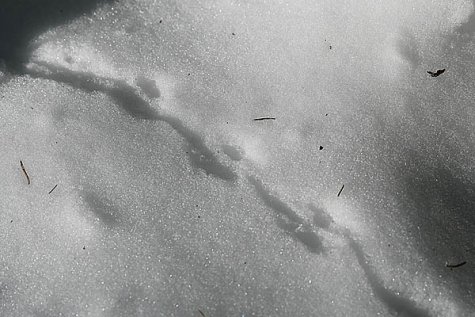Shrew tracks
Photo: Arne Ader
Translation: Liis
Track of shrew in snow
Common shrew Mets-karihiir Sorex araneus
Laxmann's shrew Laane-karihiir Sorex caecutiens
Eurasian pygmy shrew Väike-karihiir Sorex minutus
European least shrew Kääbus-karihiir Sorex minutissimus
The amazingly tiny shrews inhabit forests as well as parks, stands of shrubs, floodplain meadows... They use the burrows or tunnels of other rodents to live in, on their own they like to burrow under tree stumps.
They are actively busy around the clock because the activity of a shrew only lasts very briefly (maybe a quarter of an hour) followed by a period of sleep lasting about as long.
Shrews are difficult to tell apart even for an expert, and even observing them is complicated – we have to do with shy mice with a secretive way of life. Even when we hear their doings, the actor itself is not visible in most cases, and even if we see it for a moment, it is never certain whom we had to do with.
The common shrew and Laxmann’s shrew are larger, body length on average more than five centimetres plus as much again of tail length, and weight more than five grams; the pygmy shrew is only slightly smaller.
The dwarf shrews are really "microscopic“ and they are scarce in the whole distribution area: body length starting at three centimetres, to that comes a couple of centimetres of tail, and the weight of smaller specimens is only one and a half grams.
They feed on seeds of trees and shrubs, insects, the larger shrews on earthworms – whoever can be overpowered. Their metabolism is fast, and in order to keep up the body temperature in winter they have to eat more than their own body weight during a 24-hour period. They have many enemies, and the whole life is spent on a few hundred square metres.









